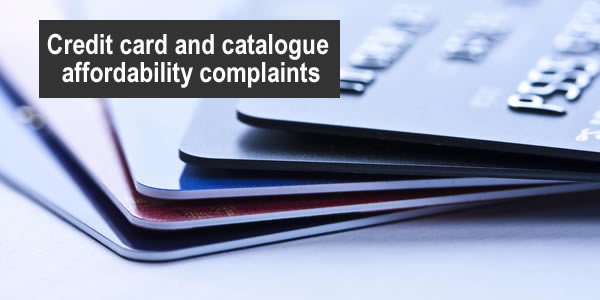 Have you had a catalogue, credit card or store card where your credit limit was too high? So high that the monthly repayments were hard to manage and you got into more debt?
Have you had a catalogue, credit card or store card where your credit limit was too high? So high that the monthly repayments were hard to manage and you got into more debt?
Many people were originally given an OK limit, but the lender kept increasing it too high.
You may have a good complaint that the lender was irresponsible in allowing you to borrow so much that the debt was unaffordable.
This article explains how to complain and ask for a refund of the interest you have paid.
What is “affordable”?
The regulator’s rules
You may have made every payment on time, but the debt is still unaffordable.
The following is my summary of the regulator’s rules:
- a lender must check if credit is affordable when you apply for it. A mortgage lender will ask for bank statements, but a catalogue offering a £400 credit limit doesn’t have to go into so much detail;
- a lender should also make checks before increasing a credit limit;
- credit isn’t affordable if paying it leaves you short of money for your bills, normal expenses, and your other debts;
- if you have to borrow more most months, this would not be affordable;
- you must be able to repay the balance within a reasonable period. Paying the minimum amount is OK for a while, but not for a long time.
Good reasons to complain
If the lender could see any of these on your credit record, they should probably have declined your original application:
- recent credit record problems: defaults, missed payments, or arrangements to pay, mortgage arrears, payday loans;
- you already had a different credit card with the same lender where you were only making minimum payments;
- other credit cards where you were near your limit and persistent overdraft usage. Here is an Ombudsman decision saying Zopa should not have given quite a low initial limit in this situation;
- a level of borrowing that looks too high in relation to your income.
Your credit limit should not later have been increased unless you could afford it. In addition to the points above, the following should have also warned the lender you were in difficulty already:
- making minimum payments for a long while;
- making a minimum repayment but then using the card to pay for food or petrol so the balance never drops;
- using a lot of your limit for a long period;
- significant gambling the lender was aware of (this could be gambling on your bank statement if the credit card lender was from the same bank);
- recent missed payments or an arrangement to pay on this account or any others on your credit record;
- your overall level of debt on your credit record has increased.
When your lender increased your credit limit, you don’t need the exact dates before you start a complaint, my template asks for the details.
How to complain
The email address to use
The best way to complain is by email. It’s free, instant and you have a record of what you sent and when.
Here is a list of credit card and catalogue email addresses to use for the banks and major lenders.
Template to use
I’ve invented some examples so you can see how a complaint should read. Change/delete the bits in italics to tell your story.
I want to complain about irresponsible lending for my Barclaycard account number 987654/444.
My date of birth is dd/mm/yy. The email address I used for this account was myaddress@whatever.com.
Then say they should never have given you the account:
You should never have allowed me to open an account with such a large credit limit. When I applied in 2018, you should have checked my credit record and would have seen I had recent missed payments to a credit card and a default only two months before on a loan.
AND/OR say that they should not have increased your credit limit:
You should never have increased my credit limit in 2021. At that time I had only made minimum payments on this credit card for a long while and/or I was using a very high level of my credit limit.
If you had properly checked my credit record before increasing my limit, you would have seen that in the two years since my account with you was opened, I had got additional late payment markers and defaults and/or taken out a lot of other credit. This should have warned you I was struggling with my finances and it was not responsible to lend more. By increasing my credit limit you made my financial position worse. Instead you should have offered me forbearance by freezing the interest on the card.
I do not know the exact months of these credit limit increases. In your reply to this complaint, please tell me the dates and amounts.
If the lender should already have known you had problems with your account, mention these
You should also have realised that I was having difficulty because:
of the late payment charges you added to my account
I had missed two payments to you the year before in 2017
I had already asked you on the phone if it was possible to stop adding interest for a while.
End with asking for a refund:
I would like you to refund me all the interest I paid and any late payment charges from the point the account was opened
OR
I would like you to refund me all the interest I paid and any late payment charges after you increased my credit limit in 2021.
I would also like any late payment and default markers to be removed from credit records after this point.
Think about these points before complaining
Timing
These complaints can be made if your account is still open, or if it is closed and settled, or if it is with a debt collector (NB the complaint goes to the original lender, not the debt collector.)
You can complain if you already have a CCJ for the debt. Add a sentence to the template saying you want the CCJ removed as part of the settlement of your complaint.
If you have had an IVA or bankruptcy after these problems, or if you are still in a DRO, then ask in the comments below, as this can be complicated.
Old accounts
The Financial Ombudsman (FOS) can only go back to April 2007, when the law changed to allow these complaints.
Many lenders will reject complaints about something that was more than 6 years ago and say the ombudsman won’t look at them. But FOS will often look at these “old” accounts if they have still been open within the last 6 years.
If your account was opened in 2015 but the lender increased your limit in 2021, then that limit increases are within the last 6 years and can definitely be looked at. The Ombudsman may also decide they can go back further.
A better approach for old defaulted accounts?
If your account was opened a long while ago and you defaulted and still owe a balance, perhaps in a DMP, think about asking the debt collector to produce the Consumer Credit Act agreement for the account.
If the current creditor can’t produce a proper copy of the agreement, the debt cannot be enforced in court and you can simply stop paying anything to it. This applies to all credit cards, store cards and catalogues.
It may be that the balance on the account is larger than any refund you might get. In which case if the CCA agreement cannot be produced, you would be better off.
Is a refund what you really need?
This depends how large your current financial problems are.
Complaining about newish debt will often only get the interest removed – you still have to repay what you borrowed. Don’t spend months arguing with lenders and going to the ombudsman if you will still be in a mess even if you win.
So phone National Debtline on 0808 808 4000, tell them you are thinking about affordability complaints but you would like to know what your other debt options are.
Poor reasons to complain
You can’t complain just because the interest rate was high or because you have paid them a fortune over the years.
A poor credit score on its own isn’t a reason why you shouldn’t have been given an account. But if your credit score was poor because you were having a lot of problems with your existing debt, the account should have been refused.
You won’t win an affordability complaint if something unexpected went wrong later in your life. If you had been managing a credit card fine for years but then you lost your job or separated from your partner, this isn’t the lender’s fault. here you may still need help to get interest stopped on the cards – talk to StepChange or National Debtline.
Don’t be put off by a rejection or a poor offer
Lenders often reject good cases
If a lender rejects your complaint or offers a low “goodwill” gesture, don’t be fobbed off – they want you to give up.
Here are some bad or irrelevant comments lenders sometimes make when rejecting a complaint:
- you had made all the payments to them on time – that doesn’t mean you could manage a higher limit;
- the account was opened over 6 years ago – if it was open in the last 6 years the Ombudsman may look at it;
- you could have rejected the limit increase – they still shouldn’t have offered it if it was unaffordable.
You know if this car or catalogue has caused you difficulty – it’s easy to send a case to the ombudsman. Don’t delay doing this!
How to send a case to FOS
Send FOS a complaint using their online form. You can use bits of what you put in your complaint to the lender. If the lender has rejected your complaint or given a poor offer, say why you think this wrong.
The FOS form at the end asks you to add supporting documents. Don’t worry if you don’t have A copy of your credit or finance agreement – lots of people don’t. The lender will supply a copy to FOS if FOS asks for it. Don’t delay sending a complaint to FOS while you try to get this from the lender.
If your credit record shows that you had other debt problems, send FOS a copy of it. If you have kept someold credit reports, send the oldest one you have, otherwise send the current one. Also get your bank statements if they will support your complaint and send those to FOS too.
FOS is a friendly service but not fast. Just use normal English, not legal terms. Using a claims company or a solicitor doesn’t help or speed this up.
Ask questions below!
There are hundreds of comments from readers who are using this template. It’s a good place to see how these complaints often go and to ask any questions.
More Debt Camel articles:

FAQs about Affordability claims

Can you get an overdraft refund?

Could a Debt Relief Order help you?
